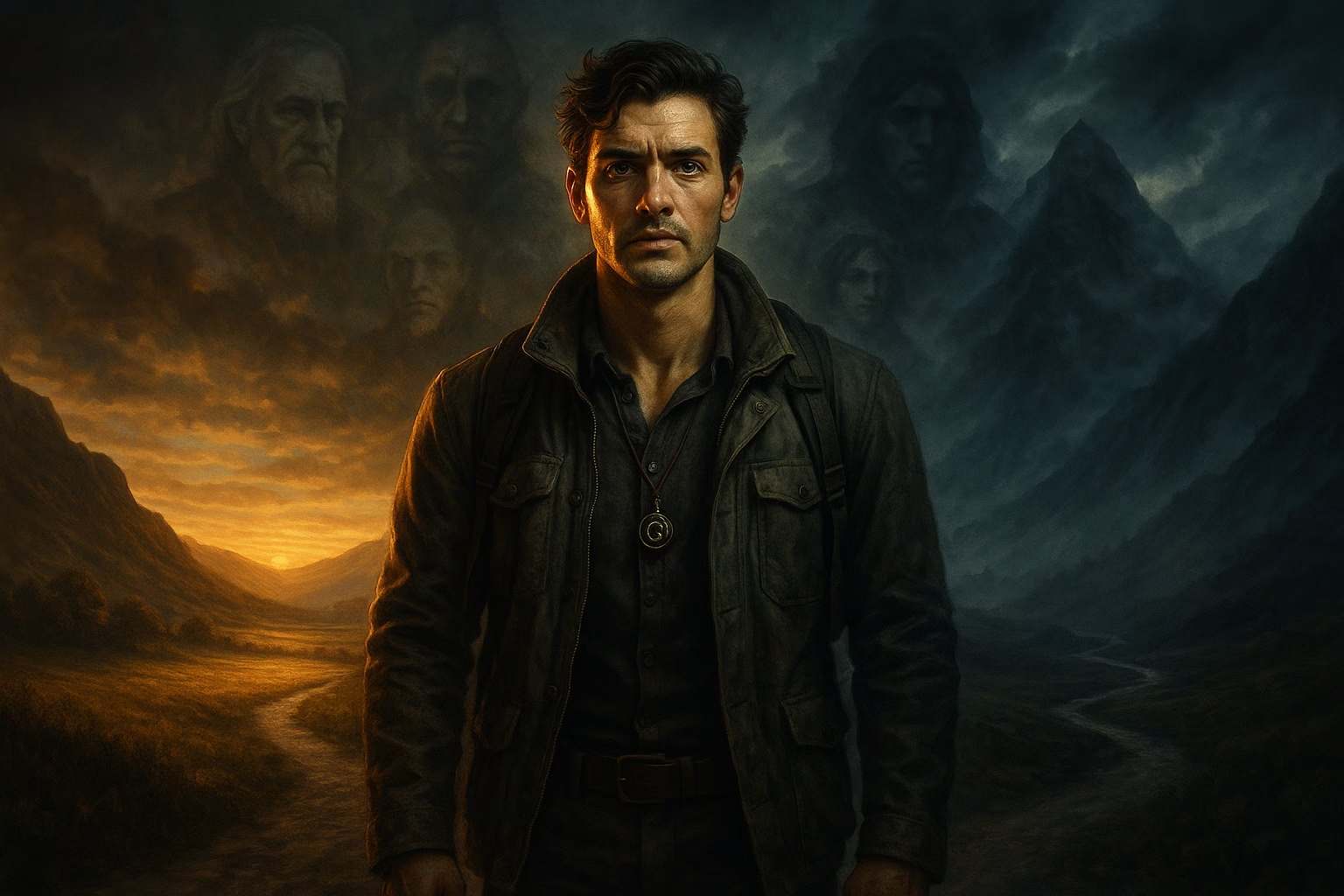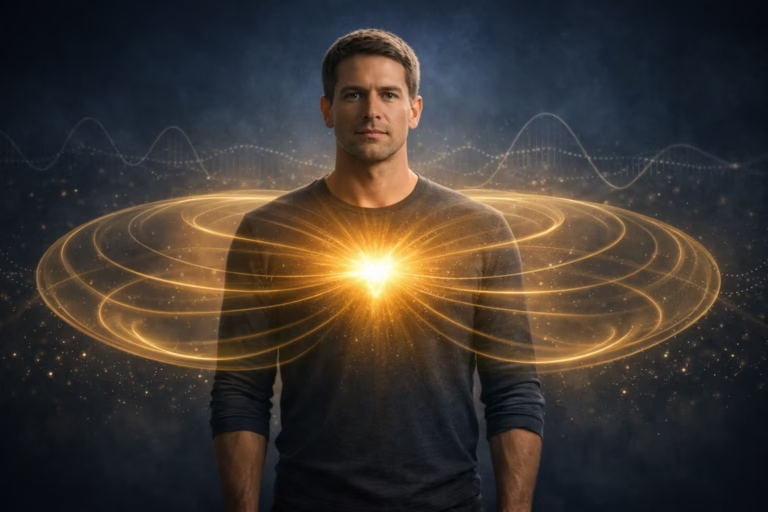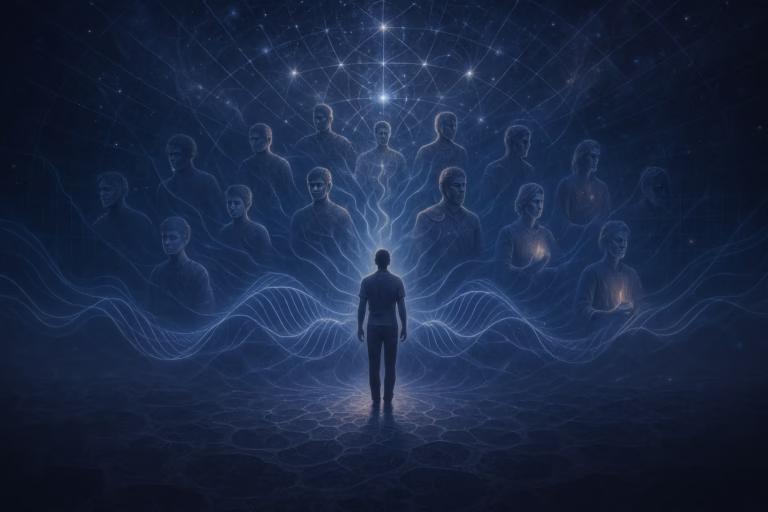PODCAST: The Hero’s Journey Within: Why Your Life Feels Like a Story
Introduction: The Unspoken Narrative of Our Lives
Human existence is often perceived as a chaotic sequence of events, a series of random occurrences that we must simply endure. Yet, from the earliest oral traditions to the latest blockbuster films, humanity has continually returned to a single, recurring narrative. It is a story so deeply embedded in our collective psyche that we instinctively recognize its rhythm in our own lives: the quiet beginnings, the sudden challenges, the struggle for growth, and the eventual, hard-won triumph. This universal story, which mythologist Joseph Campbell termed the “monomyth” or the Hero’s Journey, is not merely a formula for fiction; it is a profound blueprint for personal transformation.1
This framework describes the common arc in which a protagonist sets out from a familiar world, undergoes transformative adventures, and returns home, forever changed. At its core, the Hero’s Journey is a cycle of departure, initiation, and return.4 Complementing this external map is the internal cartography of Carl Jung’s analytical psychology, particularly his concept of archetypes. Jung argued that archetypes are universal, inherited patterns of thought and behavior residing in a “collective unconscious” shared by all human beings.5 These archetypes manifest as symbolic figures and themes in our dreams, myths, and stories, providing the psychological language for our inner lives.6
This report explores the powerful synergy between Campbell’s monomyth and Jung’s archetypes. It posits that understanding this relationship can provide a clear and actionable map for navigating the challenges of one’s own life. By examining how mythology reflects universal psychological patterns, we can learn to identify our place in our own unfolding narrative—whether we are hearing a call to adventure, facing an ordeal, or returning with new wisdom. The analysis will provide examples from literature and spiritual traditions, as well as practical steps for using the Hero’s Journey as a framework for personal growth and finding meaning in our challenges.7
The Monomyth as a Blueprint for the Human Soul
The Hero’s Journey offers a three-act structure—Departure, Initiation, and Return—that serves as a flexible template for every heroic story. This structure is not a rigid checklist but a profound cycle of transformation that mirrors our own lives.4
The Departure: Hearing the Call to Adventure
The journey begins in what Campbell calls the “Ordinary World,” the familiar, safe place where the hero’s story starts.3 This is the hero’s everyday life, where crucial details about their nature and outlook on the world are established, allowing the audience to identify with them as a human being, just like us.10 For Frodo Baggins, this world is the peaceful Shire.9 For a modern individual, it might be a comfortable but unfulfilling career or a life lived according to others’ expectations.
The inciting incident is the “Call to Adventure,” which disrupts the comfort of this ordinary world and presents a challenge or a quest.10 This call can take many forms: a message, a sudden life crisis, or a persistent inner yearning for something more.7 The hero’s initial response is often the “Refusal of the Call” due to fear, a feeling of inadequacy, or a strong desire to remain in the safe haven of the known world.10 This moment of inner conflict is vital because it makes the hero relatable; it mirrors our own resistance to change and our fear of the unknown.10
At this critical juncture, a “Mentor” figure appears to offer guidance, tools, or self-confidence.3 This can be an external person, like Gandalf guiding Frodo 9, but a deeper understanding reveals that the mentor is often a manifestation of the hero’s own inner wisdom and potential.14 This guidance dispels the hero’s doubts and gives them the courage to take the final step, “Crossing the Threshold,” and enter the new world of adventure with unfamiliar rules and dangers.10 This action is a powerful sign of the hero’s commitment to their quest and whatever lies ahead.10
The Initiation: The Descent into the Unknown
This is the most extensive and challenging phase of the journey, filled with growth and transformation. Once the hero has crossed the threshold, they are confronted with a series of “Tests, Allies, and Enemies” that force them to adapt and evolve.3 This phase is about learning the rules of the new world, forging a support network, and discerning who can be trusted.12 In mythology, this is Odysseus battling the Cyclops, navigating the waters of Scylla and Charybdis, and resisting the Sirens.4 In a personal context, this may involve navigating a new job’s political landscape, building new friendships in a new city, or struggling through a difficult project.
The climax of this phase is “The Ordeal,” a central, life-or-death crisis where the hero confronts their greatest fear or deepest inner conflict.3 This is not simply a physical battle; it is a psychological “death and rebirth” where the hero’s old self perishes, and a new, more powerful self is born from the crucible of the experience.11 Frodo’s struggle to destroy the One Ring in the fires of Mount Doom is a classic example of this moment, representing a literal and symbolic abyss.9 The successful navigation of this ordeal results in the “Reward”—the treasure, new knowledge, or “elixir” that the hero has won.3
The Return: Bringing the Elixir Home
After the reward is won, the hero must begin “The Road Back” to the ordinary world. This journey can be perilous and is often marked by a “Refusal of Return,” as the transformed hero may find their old life boring or unappealing.9 Before finally reaching home, the hero faces a “Resurrection,” a final test where they are reborn again—often psychologically—to prepare them for leadership upon their return.3
The journey concludes with the hero’s “Return with the Elixir.” The hero, purified by their trials, returns to their community bearing a boon that has the power to transform the world, as the hero themselves has been transformed.3 This completes the cycle and restores balance, as seen in Odysseus’s return to Ithaca to reclaim his kingdom and restore order.9
A profound aspect of this framework is its ability to serve as an extended “rite of passage” for the self.3 Just as we mark our lives with milestones like graduations and weddings, the Hero’s Journey provides a narrative for our most significant personal transitions. The journey’s adaptability is precisely what makes it so universally applicable, serving as a map for both mythical figures and for our own inner lives.
The Hero’s Journey Stages for the Inner Life |
Call to Adventure |
Refusal of the Call |
Meeting the Mentor |
The Ordeal |
Resurrection |
Return with the Elixir |
The Inner Cast of Characters: Jungian Archetypes and the Psyche
While the Hero’s Journey provides the plot of our lives, Jungian archetypes provide the cast of characters. These universal, inherited patterns of thought and behavior reside in the “collective unconscious” and shape our understanding of the world, appearing in myths, dreams, and art across all cultures.5 Myths, in this sense, are psychological projections that give form to these unconscious patterns, allowing us to explore complex emotions and concepts symbolically.6
The Hero Archetype: The Call to Courage
The Hero archetype represents the desire for achievement, the need to overcome challenges, and the courage to act in the face of adversity.6 This is the part of us that seeks strength, ingenuity, and stability, offering a “dragon slayer’s mentality” when we must navigate difficult emotional times or trauma.17 It is the force that propels us to answer the call to adventure and endure the road of trials. While the hero may be an unlikely candidate, this archetype is a fundamental aspect of human experience that helps us meet trials directly.3
The Shadow Archetype: Embracing the Darkness for Wholeness
The Shadow archetype is one of the most powerful and misunderstood figures in Jungian psychology. It is the hidden, suppressed side of our personality, a representation of everything we deny or perceive as negative.5 In mythology and literature, the Shadow is often personified as a villainous character, such as Gollum in The Lord of the Rings or Grendel in Beowulf.6 These figures embody the aspects of ourselves that we do not want to acknowledge and with which we do not identify.5
However, the Shadow is not simply a negative force to be defeated. Its suppression can lead to internal conflicts and feelings of inadequacy.6 The purpose of the Hero’s Journey is not to eliminate the Shadow but to confront and integrate it.5 The Hero’s own vulnerability and weaknesses, for example, can become a bloated ego if not balanced by an understanding of their Shadow.17 The journey’s ultimate ordeal is often a symbolic battle to make the unconscious conscious, and it is through this process that the hero achieves psychological wholeness.18 By embracing the Shadow, rather than repressing it, the hero unlocks a constant source of elevation and growth, moving beyond a simple sense of victory to a more complete and authentic sense of self.17
The Mentor Archetype: The Voice of Inner Wisdom
The Mentor, also known as the Sage or “Wise Old Man” (senex), is a figure of wisdom and knowledge who guides the hero on their journey.6 This archetype provides the hero with essential lessons, training, or insight needed to face their trials.10 Examples range from Gandalf and Obi-Wan to the goddess Athena, who guides Odysseus.9
A profound aspect of the Mentor archetype is its function as a symbol for our own inner potential.14 While the Mentor often appears as an external figure, they are fundamentally an aspect of ourselves.14 This inner mentor is the voice of our deepest wants, providing the strength and wisdom to achieve what we must do through “untapped resources of abilities and thought that we didn’t know we had”.14 This perspective changes the hero’s relationship with the mentor from one of dependence to one of co-creation, where the mentor gives the hero the opportunity to “create themselves”.14 It is a journey of finding the power within.
This archetype also has a dark side that requires careful navigation.18 The Shadow of the Sage can manifest as dogmatism, rigidity, or an unhelpful, critical internal voice.18 The lesson here is that even our inner wisdom must be engaged with an open and reflective mind, lest it become a source of judgment and self-rejection. The journey of the Mentor is also one of individuation, as seen in the transformation of Gandalf after his confrontation with the Balrog in The Lord of the Rings.18 This highlights the complex, living nature of archetypes and the importance of integrating them for true personal growth.
Key Archetypes of Your Inner World |
Archetype |
Hero |
Shadow |
Mentor/Sage |
A Mind Wired for Narrative: The Psychology of a Life Story
The enduring power of the Hero’s Journey and archetypes is not a coincidence. It is rooted in how the human brain is fundamentally wired to translate experience into narrative form. Understanding this cognitive basis provides a scientific foundation for why our lives feel like a story and how we can use this knowledge for personal growth.
The Brain’s Craving for Stories
Neuroscience reveals that our attraction to stories is a core part of our cognitive machinery.22 The human brain is a pattern-detecting organ that imposes order on chaos, and stories provide a perfect structure for this process.22
Firstly, stories create an immersive experience that goes beyond simple listening. When we hear a story, our brains react as if we are experiencing the events firsthand. The auditory cortex processes the words, while our sensory and motor cortices ignite to imagine sights, sounds, and even physical actions.22 This “neural mirroring” helps explain why we feel a physical reaction—a tingle of suspense or a pang of sadness—when a character faces a trial.22
Secondly, stories are a fundamental tool for social connection. Research shows that listening to a story can trigger the release of oxytocin, a neurochemical responsible for empathy and social bonding.23 This “love hormone” makes us more sensitive to the moral cues in the story and fosters a sense of intimacy with the characters and the storyteller.23 This mechanism explains why we feel such a deep connection to fictional heroes; their struggles become a substitute for a real-life social interaction.23
Finally, stories are essential for meaning-making and existential understanding.22 Our brains crave “narrative resolution,” and stories provide coherent plots that help us digest and retain information.22 This neurological drive for closure and meaning illuminates why we are so drawn to narratives with a clear beginning, middle, and end.
The Narrative Identity: Building, Not Finding, the Self
The human mind’s wiring for narrative extends to our very sense of self. The theory of narrative identity posits that individuals form their identity by integrating their life experiences into an internal, evolving life story.24 This personal narrative, which includes characters, plots, and themes, provides an individual with a sense of unity and purpose.24 It is the story that answers the questions: “How did I get here, who am I, and where am I going?”.25
This perspective offers a powerful counter-narrative to the common cultural myth of “finding yourself.” Many people are conditioned to believe that a fixed, authentic self is waiting to be uncovered, leading to paralysis and disillusionment if a sudden revelation does not occur.26 However, as developmental psychology and neuroscience suggest, identity is not a hidden treasure to be found; it is something we actively build.26 Our brains are constantly evolving through neuroplasticity, allowing us to reshape our habits, beliefs, and thought patterns with intentional practice and new experiences.26 The Hero’s Journey, in this context, is the perfect framework for this process, as it is a story of active construction and purposeful action, not passive discovery.
Myth as a Mirror for the Collective and Individual Psyche
Myths serve as profound psychological projections that allow societies and individuals to process complex emotions, fears, and desires.16 They provide symbolic outlets for aggression and trauma while offering behavioral models and cautionary tales that reinforce cultural values.16
Furthermore, myths and stories have an evolutionary utility that goes beyond mere entertainment.29 They allow us to engage in “mental time travel,” a cognitive ability to recall the past and imagine the future.30 By mentally simulating a hero’s journey and confronting their challenges, we can evaluate a universe of “counterfactuals”—alternative realities and outcomes.29 This allows us to learn from a hero’s triumphs and mistakes without having to experience them firsthand, effectively honing our judgment and improving our problem-solving skills.29 This evolutionary function explains why stories, particularly those with a clear narrative arc of conflict and resolution, have remained an integral part of the human experience for millennia.23
Your Journey’s Compass: A Practical Guide for Self-Awakening
The Hero’s Journey is not just a tool for analyzing books or movies; it is a compass for navigating your own life. By viewing your challenges and transitions through this narrative lens, you can find a profound sense of meaning and purpose in your struggles.
Reading Your Life’s Story: How to Find Your Place on the Map
The first step is to become a reflective reader of your own life story. Ask yourself a series of questions to identify where you are on the journey’s map:
- Are you in your “Ordinary World,” feeling a persistent sense of dissatisfaction or lack? 3
- Have you received a “Call to Adventure” in the form of a new opportunity, a sudden crisis, or a deep desire for change? 8
- Are you in the middle of “The Ordeal,” confronting a major challenge or your greatest fear? 3
- Are you on “The Road Back,” trying to integrate a hard-won lesson from a past triumph?
Engaging in self-reflection through journaling or mindfulness can help you gain clarity.8 As Joseph Campbell famously said, “The cave you fear to enter holds the treasure you seek”.8 By framing your challenges as opportunities for growth, you can foster a mindset of curiosity and determination, rather than fear and avoidance.7
Heeding the Call of the Hero Within: Practical Steps
Applying the Hero’s Journey as a personal development map requires conscious effort and a willingness to engage with both the external world and your inner psychological landscape.
- Step 1: Acknowledge the Call. The journey begins when you embrace life’s challenges and opportunities as invitations to embark on a new chapter.8 Do not allow the natural response of fear and uncertainty to lead to a “Refusal of the Call”.7
- Step 2: Cultivate Your Inner Mentor. Recognize that the wisdom you need is often within you.14 Engage in introspection and self-reflection to access this internal voice.18 Seek external mentors, but remember that the goal is not to be created in their image, but to find the strength to “create yourself”.14
- Step 3: Confront Your Shadow. The “Ordeal” of the journey is often a battle against the “dark side” of the self.17 To achieve wholeness, you must confront and integrate the weaknesses, fears, and repressed traits you have denied.5 Journaling about moments of shame, anger, or inadequacy can be a powerful way to bring these aspects into conscious awareness.
- Step 4: Engage Fully in the Ordeal. True growth happens in the “Road of Trials” and “Ordeal” stages.7 This is where you can cultivate “deep engagement” and experience a transformative “flow state”.8 This stage, in spiritual traditions, is often described as the “death of the ego,” a humbling surrender to forces beyond your control that ultimately leads to rebirth.31
- Step 5: Embrace the Return. The hero’s triumph is not just for themselves, but is meant to be shared with their community.3 The “Return with the Elixir” is about integrating the lessons you have learned into your daily life and using them to inspire and uplift others.8 This final step completes the cycle and allows you to find a profound sense of meaning in your accomplishments, a key element of well-being according to the PERMA model in positive psychology.8
A Hero’s Guide: From Myth to Meaning |
Journey Phase |
Departure |
Initiation |
Return |
Conclusion: Becoming the Author of Your Own Epic
The enduring resonance of the Hero’s Journey and Jungian archetypes lies in their ability to reflect a fundamental truth about human experience: our lives are not random, but an unfolding narrative.1 This report has demonstrated that this narrative is not merely a metaphor; it is a profound psychological and neurological reality.22 By recognizing our place on this ancient map, we can begin to see our struggles not as tragedies but as pivotal plot points, our fears not as weaknesses but as challenges to be overcome, and our victories not as final destinations but as the beginning of a new chapter.3
The journey teaches us that our identity is not a fixed, authentic self waiting to be discovered, but a living document that we actively build through conscious choices and purposeful action.24 The Hero, the Shadow, and the Mentor are not just characters in a story; they are the fundamental psychological forces that shape our growth.6 By engaging with these forces, we can find the courage to embark on our quests, the wisdom to navigate our trials, and the strength to integrate our newfound knowledge, or “elixir,” back into our lives and our communities.7
In the grand tapestry of life, each of us is both the protagonist and the author. The power of the Hero’s Journey is that it gives us a language to understand our story and the tools to write its most meaningful chapters. Embrace the call, for your next great adventure awaits, and you are the hero of your own unfolding epic.
Works cited
- orias.berkeley.edu, accessed August 13, 2025, https://orias.berkeley.edu/resources-teachers/monomyth-heros-journey-project#:~:text=Joseph%20Campbell’s%20Monomyth%2C%20developed%20in,traditions%20across%20time%20and%20culture.
- Monomyth: Hero’s Journey Project – ORIAS, accessed August 13, 2025, https://orias.berkeley.edu/resources-teachers/monomyth-heros-journey-project
- The Psychology of The Hero’s Journey – World Builders, accessed August 13, 2025, https://www.worldbuilders.ai/p/heros-journey-psychology
- The Odyssey and Hero’s Journey: An Analytical Exploration – Kaitlyn …, accessed August 13, 2025, https://kaitlynessays.com/the-odyssey-and-heros-journey/
- Jungian archetypes – Wikipedia, accessed August 13, 2025, https://en.wikipedia.org/wiki/Jungian_archetypes
- Carl Jung’s Archetypes – Structural Learning, accessed August 13, 2025, https://www.structural-learning.com/post/carl-jungs-archetypes
- The Hero’s Journey – A Model For Personal Growth – UKCPD, accessed August 13, 2025, https://ukcpd.co.uk/the-heros-journey-a-model-for-personal-growth/
- The Hero’s Journey to Well-Being | Psychology Today, accessed August 13, 2025, https://www.psychologytoday.com/us/blog/beyond-school-walls/202309/the-heros-journey-to-well-being
- The Hero’s Journey: Archetypes and Motifs in Classic Literature …, accessed August 13, 2025, https://heritageclassicbooks.com/heros-journey-literature/
- The Hero’s Journey – Mythic Structure of Joseph Campbell’s Monomyth – Movie Outline, accessed August 13, 2025, https://www.movieoutline.com/articles/the-hero-journey-mythic-structure-of-joseph-campbell-monomyth.html
- The Psychology of The Hero’s Journey | by Nathan Baugh | Medium, accessed August 13, 2025, https://medium.com/@nathan.baugh/the-psychology-of-the-heros-journey-0bda883de114
- The Stages of the Hero’s Journey, accessed August 13, 2025, https://www.tlu.ee/~rajaleid/montaazh/Hero%27s%20Journey%20Arch.pdf
- Joseph Campbell’s Hero’s Journey: A Better Screenplay in 17 Steps – StudioBinder, accessed August 13, 2025, https://www.studiobinder.com/blog/joseph-campbells-heros-journey/
- The Human Psychology of the Mentor and Mentor Variations – Swidgers, accessed August 13, 2025, https://www.swidgers.com/?page_id=368
- 12 Jungian Archetypes: The Foundation of Personality – Positive Psychology, accessed August 13, 2025, https://positivepsychology.com/jungian-archetypes/
- Psychological interpretations of myths | Myth and Literature Class Notes – Fiveable, accessed August 13, 2025, https://library.fiveable.me/myth-and-literature/unit-11/psychological-interpretations-myths/study-guide/XgZkZHC4UItBl5Lt
- The Hero and the Hero’s Shadow: The Archetype That Defines Us …, accessed August 13, 2025, https://www.psychologytoday.com/us/blog/tales-of-grief/202203/the-hero-and-the-heros-shadow-the-archetype-that-defines-us
- Discovering Archetypes: The Sage Archetype – Inner Space Therapy, accessed August 13, 2025, https://innerspacetherapy.in/sage-archetype
- Wise old man – Wikipedia, accessed August 13, 2025, https://en.wikipedia.org/wiki/Wise_old_man
- What is this wise old man archetype? : r/Jung – Reddit, accessed August 13, 2025, https://www.reddit.com/r/Jung/comments/ejrwyq/what_is_this_wise_old_man_archetype/
- Sage Archetype – Carol Pearson, accessed August 13, 2025, https://www.carolspearson.com/archetype-pages/sage-archetype
- The Power of Storytelling: How Our Brains Are Wired for Narratives, accessed August 13, 2025, https://www.innovativehumancapital.com/article/the-power-of-storytelling-how-our-brains-are-wired-for-narratives
- Why do our brains demand a narrative? – Headspace, accessed August 13, 2025, https://www.headspace.com/articles/brains-demand-narrative
- Narrative identity – Wikipedia, accessed August 13, 2025, https://en.wikipedia.org/wiki/Narrative_identity
- The Development of Personal Narratives and Narrative Identity Kate C. McLean We – OSF, accessed August 13, 2025, https://osf.io/xe6gq/download
- The Myth of Finding Yourself and Why Identity is Something You Build, Not Discover, accessed August 13, 2025, https://www.brainzmagazine.com/post/the-myth-of-finding-yourself-and-why-identity-is-something-you-build-not-discover
- The Myth of Self Discovery: I am the Captain of my Ship, the Maverick of my Future! – 14 East, accessed August 13, 2025, https://fourteeneastmag.com/index.php/2016/10/21/965/
- From Mythology to Psychology – an essay on the Archaic Psychology in Greek Myths, accessed August 13, 2025, https://ejop.psychopen.eu/index.php/ejop/article/view/351/351.html
- On the Evolutionary Uses of Storytelling – Literary Hub, accessed August 13, 2025, https://lithub.com/on-the-evolutionary-uses-of-storytelling/
- The Ape That Lived to Tell the Tale. The Evolution of the Art of Storytelling and Its Relationship to Mental Time Travel and Theory of Mind – Frontiers, accessed August 13, 2025, https://www.frontiersin.org/journals/psychology/articles/10.3389/fpsyg.2021.755783/full
- The Hero’s Journey Parallels the Spiritual Journey – University of Richmond Blogs |, accessed August 13, 2025, https://blog.richmond.edu/heroes/2025/07/11/the-heros-journey-parallels-the-spiritual-journey/
- The Hero’s Journey – Center for Action and Contemplation, accessed August 13, 2025, https://cac.org/daily-meditations/the-heros-journey/
- The DhIra- The Inner Journey Of The Hero (Exploring the Indic perspective on the Hero’s journey and its comparison to Joseph Campbells Hero’s Journey) – Indica Today, accessed August 13, 2025, https://www.indica.today/research/conference/the-dhira-the-inner-journey-of-the-hero/




